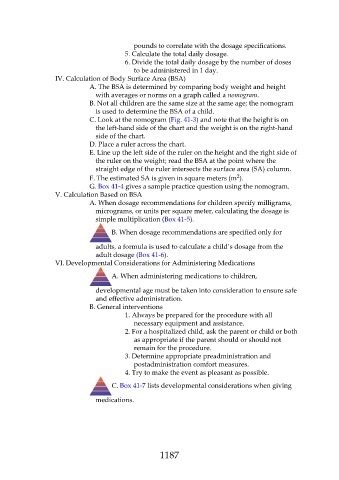Page 1187 - Saunders Comprehensive Review For NCLEX-RN
P. 1187
pounds to correlate with the dosage specifications.
5. Calculate the total daily dosage.
6. Divide the total daily dosage by the number of doses
to be administered in 1 day.
IV. Calculation of Body Surface Area (BSA)
A. The BSA is determined by comparing body weight and height
with averages or norms on a graph called a nomogram.
B. Not all children are the same size at the same age; the nomogram
is used to determine the BSA of a child.
C. Look at the nomogram (Fig. 41-3) and note that the height is on
the left-hand side of the chart and the weight is on the right-hand
side of the chart.
D. Place a ruler across the chart.
E. Line up the left side of the ruler on the height and the right side of
the ruler on the weight; read the BSA at the point where the
straight edge of the ruler intersects the surface area (SA) column.
2
F. The estimated SA is given in square meters (m ).
G. Box 41-4 gives a sample practice question using the nomogram.
V. Calculation Based on BSA
A. When dosage recommendations for children specify milligrams,
micrograms, or units per square meter, calculating the dosage is
simple multiplication (Box 41-5).
B. When dosage recommendations are specified only for
adults, a formula is used to calculate a child’s dosage from the
adult dosage (Box 41-6).
VI. Developmental Considerations for Administering Medications
A. When administering medications to children,
developmental age must be taken into consideration to ensure safe
and effective administration.
B. General interventions
1. Always be prepared for the procedure with all
necessary equipment and assistance.
2. For a hospitalized child, ask the parent or child or both
as appropriate if the parent should or should not
remain for the procedure.
3. Determine appropriate preadministration and
postadministration comfort measures.
4. Try to make the event as pleasant as possible.
C. Box 41-7 lists developmental considerations when giving
medications.
1187

